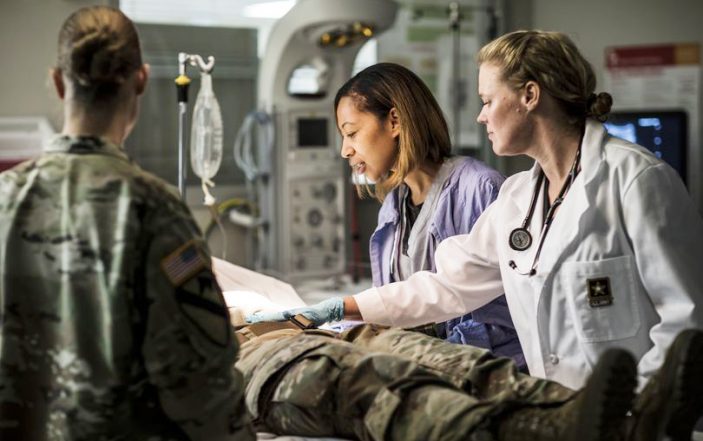More than three million service members utilize Army Medical Department facilities.
Being passionate about America and those that protect its borders is what the U.S. Army looks for in health care professionals. Army Medicine provides sustained health services and state-of-the-art research in support of our readiness while caring for America’s Sons and Daughters.
Helping others and being a leader in the healthcare field is the primary mission of the U.S. Army Medical Department (AMEDD) and a worthy choice for anyone driven by the desire to care for others at the same time as serving their country.
The AMEDD is considered one of the largest healthcare systems in the world, employing over 138,000 personnel, operating more than 400 medical centers, clinics and research facilities globally. More than three million soldiers, family members, dependent survivors, retirees, Army Reservists and National Guard members utilize these Army facilities.
There are six AMEDD officer branches (known as corps); Dental Corps, Medical Corps, Medical Service Corps, Specialist Corps, Nurse Corps and Veterinary Corps. With over 90 areas of concentration to choose from, there are a wide range of opportunities and benefits for an Army medical professional.
Maj. Steven Schauer, Emergency Medicine Physician with the U.S. Army Institute of Surgical Research at Brooke Army Medical Center in San Antonio, Texas, states he got into medicine because of his passion for science.
“Medicine is an applied science in taking care of people,” Schauer said. Brooke Army Medical Center is a Department of Defense Level I Trauma Center, and Schauer feels fortunate for the opportunity to work and learn at a premier facility.
The Army offers numerous incentives to its medical professionals, to include scholarships, loan re-payment and specialty bonus pay. One of the most attractive incentives is the F. Edward Hebert Armed Forces Health Professions Scholarship Program (HPSP), which pays 100% tuition to qualifying students for any accredited medical, dental, veterinary, specialty nursing, psychology or optometry program.
HPSP BENEFITS
- Full tuition (up to four years, depending on specialty)
- Books, equipment, other fees
- $2,300+ monthly stipend
- $20,000 sign-on bonus
- Monthly allowance for food and housing
- Salary increases with promotions, time in service and cost-of-living adjustments
According to the Association of American Medical Colleges, as of October 2018, the average medical school debt is $147,000-$236,000. The Army provides a way to achieve academic goals without the stressors of debt or financial problems. The program supports students as they navigate through school and culminate with their residency. HPSP students hold the officer rank of 2nd Lieutenant during school and are promoted to Captain upon graduation.
If you are a current healthcare student, the Army offers the opportunity to apply for specialized internships and receive specialized training. Current medical or dental school students can also receive a monthly stipend of more than $2,300 under the Medical and Dental School Stipend Program (MDSSP).
As medical professionals advance through their career, access to blended teaching, research and clinical excellence is highly sought after and is arguably the best way to prepare for unique and challenging opportunities in medicine. A great way to acquire this kind of experience is through the Graduate Medical Education (GME) programs offered by the AMEDD.
According to Schauer, life as a physician within the Army has similar requirements as a civilian doctor; residency, rotations and training, but a lot more benefits and available resources.
“The Army has given me so many different experiences. For example, you get to deploy and provide care for soldiers, people that you have something in common with,” Schauer said. “Even though we come from different backgrounds and different cultures, people that come into the Army all have one thing in common, which is that we chose to serve.”
Army medical professionals promote wellness around the globe, ensuring service members are fit enough to perform their duties, and keeping their families healthy. This could include serving at an international military medical center, being deployed to provide humanitarian services for natural disasters, relief to civilians or providing lifesaving treatment during combat operations.
The Army offers the opportunity to become a leader in your specialty while working alongside talented medical professionals. Army medicine is the spearhead for innovative care and is the most advanced in developing tools for preventing disease, treating illness, and overcoming mental and physical challenges.
As a pioneer in medicine, the Army is applying tomorrow’s technology today to our soldiers and their families. Army health care is leading the way in such areas as breast cancer, burn care, mental health, prosthetics, operating room robotics and trauma care.
“I would recommend this path to anyone,” said Maj. Schauer. “The Army has given me the opportunity to do a lot of different things I wouldn’t get to do as a civilian. That’s the beauty of the Army. We have the ability to deploy, take care of patients, become leaders in our field, and are exposed to unlimited opportunities.”
To inquire about your options as a medical professional serving your country in the U.S. Army, go to https://recruiting.army.mil/mrb/QG64
The Army Medical Department faces multiple missions of war, peacekeeping, humanitarian relief to caring for Soldiers, Retirees, and Family members at home and abroad. Statistics from 2016 on https://armymedicine.health.mil/A-Day-in-Army-Medicine state the average daily procedures in all fixed Army medical facilities and gives clear insight as to the daily workload of an Army medical professional:
- 54,799 outpatient visits
- 253 patients admitted
- 1,083 patient beds occupied
- 24,915 dental procedures
- 9,388 immunizations
- 71 births
- 12,852 radiology procedures
- 57,365 outpatient pharmacy prescriptions
- 84,806 laboratory procedures
- 401 food safety visits



